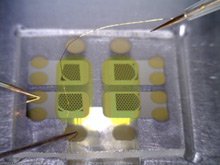Andrew Rinzler, professor of physics at the University of Florida has developed a new driving method for large OLED panels which basically brings the source and drain electrodes of a transistor closer together by stacking components on top of one another instead of side by side. The transistors are made from thin aluminum oxide film on a glass subtrate (as the drain electrode) and a layer of organic molecules as a channel. This enables good performance without the need for high-resolution lithography techniques. The new device also uses a tenth of the voltage of current OLEDs - which saves power.
 Transistors on glass
Transistors on glass
They haven't yet made a large-sized panel, but it should be possible with the new design. It can also be used to make flexible OLEDs. They are currently working to simplify the architecture in hope to bring down the cost and complexity even further.
The work was funded in part by the venture capital firm Nano Holdings.

